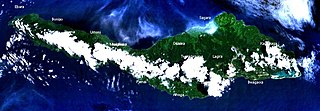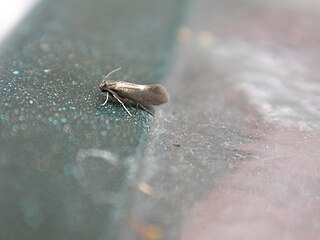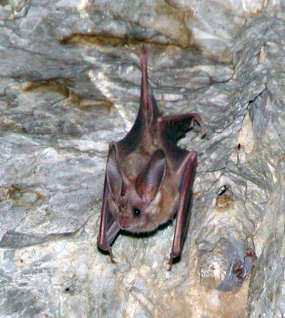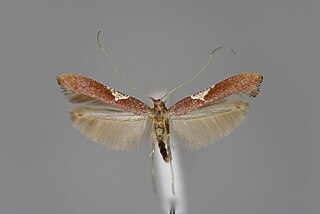Mine, mines, miners or mining may refer to:

Misima is a volcanic island in the northwest of Louisiade Archipelago within Milne Bay Province of Papua New Guinea.
Leaf Rapids is a town in north west Manitoba, Canada. The town was developed as an experimental model; a model that other northern communities could replicate as they strove for modern convenience and luxury in a northern environment. The community is located approximately 1,000 km north of Winnipeg along the Churchill River. The original (urban) community of Leaf Rapids is on Manitoba Provincial Road 391, although most of the large official town created later lies east of this community. This town is as large as a typical Rural Municipality in the more southern parts of Manitoba.

A leaf miner is any one of numerous species of insects in which the larval stage lives in, and eats, the leaf tissue of plants. The vast majority of leaf-mining insects are moths (Lepidoptera), sawflies, and flies (Diptera). Some beetles also exhibit this behavior.

The Agromyzidae are a family commonly referred to as the leaf-miner flies, for the feeding habits of their larvae, most of which are leaf miners on various plants.

Gracillariidae is an important family of insects in the order Lepidoptera and the principal family of leaf miners that includes several economic, horticultural or recently invasive pest species such as the horse-chestnut leaf miner, Cameraria ohridella.

Nepticulidae is a family of very small moths with a worldwide distribution. They are characterised by eyecaps over the eyes. These pigmy moths or midget moths, as they are commonly known, include the smallest of all living moths, with a wingspan that can be as little as 3 mm in the case of the European pigmy sorrel moth, but more usually 3.5–10 mm. The wings of adult moths are narrow and lanceolate, sometimes with metallic markings, and with the venation very simplified compared to most other moths.

Maple Leaf is a United States National Historic Landmark in Jacksonville, Florida, United States. Maple Leaf, a side paddlewheel steamship, was first launched as a freight and passenger vessel from the Marine Railway Yard in Kingston, Upper Canada in 1851. The 181-foot (55 m) sidewheel paddle steamer measured 24.7-foot (7.5 m) at the beam.

A family of primitive monotrysian moths in the order Lepidoptera, Heliozelidae are small, metallic day-flying moths with shiny smooth heads. In Europe the small adult moths are seldom noticed as they fly quite early in the spring. The larvae are leaf miners and the vacated leaf mines are distinctive because the larva leaves a large hole at the end.

The California leaf-nosed bat is a species of bat in the family Phyllostomidae. It is found in Mexico and the United States. Its natural habitat is hot deserts.

The rose leaf miner is a moth of the family Nepticulidae. It is found in all of Europe, east to the eastern part of the Palearctic realm.

Lyonetia prunifoliella is a moth in the family Lyonetiidae.

Bedellia somnulentella, the sweet potato leaf miner, is a moth in the family Bedelliidae.

Phyllonorycter coryli, or nut leaf blister moth, is a moth of the family Gracillariidae. It is found most of Europe, except the Balkan Peninsula.

Incurvaria praelatella is a moth of the family Incurvariidae. It is found in all of Europe, except the Iberian Peninsula.

Aspilapteryx tringipennella is a moth of the family Gracillariidae. It is known from all of Europe.

Caloptilia betulicola, the red birch slender, is a moth of the family Gracillariidae. It is found from Scandinavia and the north of European Russia to the Pyrenees and Alps and from Ireland to Poland and Slovakia. In the east it is found up to China, Japan and the Russian Far East.

Caloptilia stigmatella is a moth of the family Gracillariidae. It is known from the Holarctic Region, including all of Europe.
Consumer–resource interactions are the core motif of ecological food chains or food webs, and are an umbrella term for a variety of more specialized types of biological species interactions including prey-predator, host-parasite, plant-herbivore and victim-exploiter systems. These kinds of interactions have been studied and modeled by population ecologists for nearly a century. Species at the bottom of the food chain, such as algae and other autotrophs, consume non-biological resources, such as minerals and nutrients of various kinds, and they derive their energy from light (photons) or chemical sources. Species higher up in the food chain survive by consuming other species and can be classified by what they eat and how they obtain or find their food.

Argyresthia fundella is a moth of the family Yponomeutidae. It is found in most of Europe, except Ireland, Great Britain, the Iberian Peninsula, Finland, the Baltic region, Slovenia, Hungary and Greece.
















